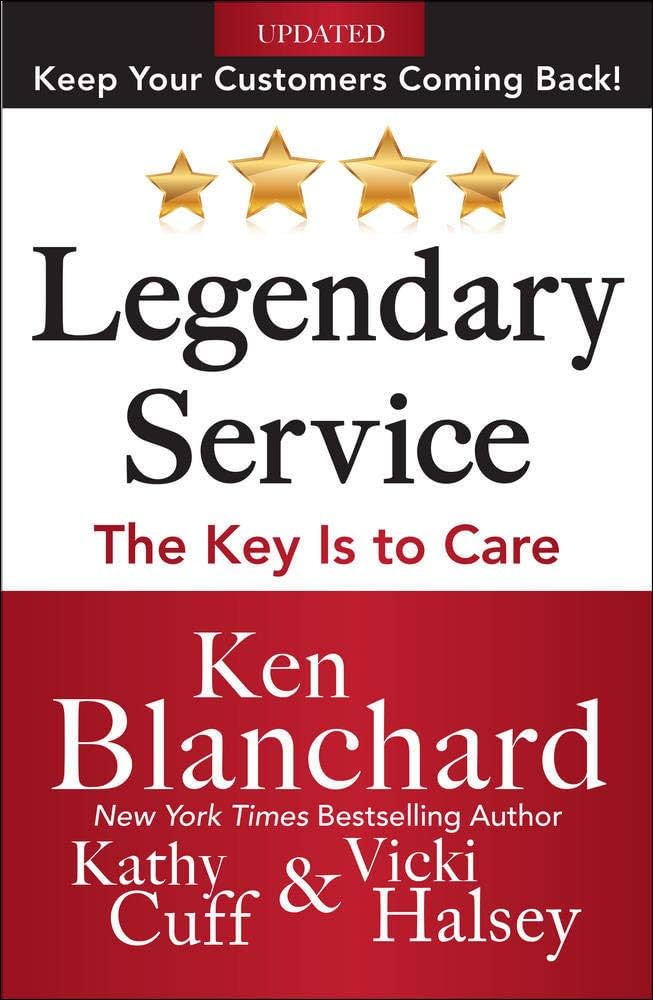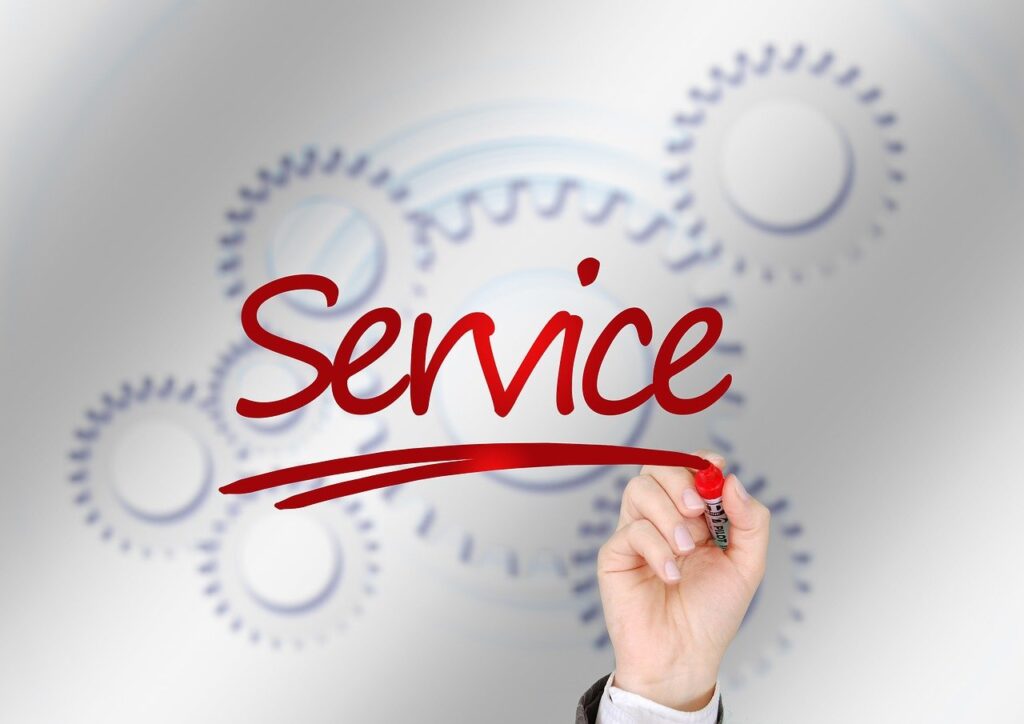Click here to return to Blog Post Intro

Customer service, both internal and external, is everyone’s job.
When was the last time you wanted to tell other people about a fantastic customer service experience you had?
When it comes to being successful in business, everything boils down to relationships. And relationships are built through service. Companies that see the importance of building relationships with their people and their customers are the ones that succeed in the long run.
Great companies realize their most important customers are their own people—employees and managers. Customer loyalty is what you get when you create a motivating environment for your people.
Here are three little ideas that can change the way your customers feel about you—because you are going to give them a personal service experience:
- Learn and use the customer’s name.
- Talk about something other than the transaction.
- Be friendly.
Try those three ideas for a week. At the end of the week, write a two-page paper that gives some real specifics about what happened when you carried out these three ideas.
If a company takes care of its people, the people will take care of the customers, and the customers will want to come back.
Great companies have learned how to let their customers know that they care about them and want to earn their business. They also know the importance of building relationships with both internal customers—their people—and external customers—the ones who buy their product or service.
Legendary Service is consistently delivering ideal service that keeps customers coming back and results in a competitive edge for your organization.
Companies can achieve Legendary Service by showing their customers they care about them.
Focusing on relationships with both external and internal customers is an organization’s most powerful competitive advantage. As one leader recognized, “We need to remember to serve each other when we can, and to treat each other in the same positive way we treat our customers.”
I-CARE Model
Ideal Service
Ideal service is about meeting the customer’s needs on a day-to-day basis by acting on the belief that service is important.
Good service is a lot simpler than people think. It’s just a matter of caring for and knowing your customers, clients, patients—whoever you’re serving. It’s about considering their needs and wanting to make them happy.
Culture of Service

To develop a Culture of Service, foster an environment that focuses on serving the customer. A true Culture of Service should include a service vision, since every organization serves customers—whether the company is for-profit, nonprofit, or even in the public sector.
An organization’s culture is made up of many things—people, history, vision, values, reputation, significant events, and even annual celebrations. A Culture of Service can exist only by intention—by creating a focus on the customer and holding everyone in the organization accountable for carrying out the service vision.
To have a true Culture of Service, you need to have the following in place:
- Senior management buy-in and support;
- All employees trained in Legendary Service—what it is, what it looks and feels like, and how to provide it; and
- A sustainability plan that includes follow-up activities, goals focused on service, and methods to measure progress.
One clinic team’s Service Vision was “To treat our patients as family and nurture them back to health.” They strive to be consistent in service and always keep the patient top of mind.
At the clinic, the team worked together to decide what their values would be and came up with these:
- Integrity in All Things
- Quality Care
- Relationships
- Learning
On a visit to a baseball game, one fan noticed a large sign attached to the scoreboard. The park’s logo was at the top, and below it were the words “We’re in the Business of Creating Major League Memories.”
To build a Culture of Service, be sure to put all people through customer service training, invite their best thoughts, and launch an internal website where you can capture feedback and celebrate successes.
Once an organization has clearly identified its service vision, the next step is to get clear on who its customers are and what they want. This is called being attentive to customers.
Attentiveness
Knowing your customers and their preferences is the hallmark of attentiveness.
Customer profiling is a great way for people in an organization to get to know the different types of customers they serve and those customers’ specific preferences. That way, they can make sure they are not only meeting each customer’s individual needs but also looking for ways to continuously improve the service they are providing.
Attentiveness to customers is not only knowing each of them and their personal preferences, but also paying attention to the impression you are making on them.
Research shows it’s the last impression you make that can actually shape and define someone’s entire experience.
When you are the service provider, a simple word or gesture on your part is sometimes all that’s needed to show customers that you’re in tune with them and you care about them as people, not just as customers. That kind of connection can instantly create customer loyalty.
Responsiveness
Responsiveness is demonstrating a genuine willingness to serve others as you fulfill their individual needs.
Being responsive to your customers goes hand in hand with being attentive to their needs and preferences. To be as responsive as possible to your customers, listen carefully when they tell you what they need. If you have an unhappy customer, keep a positive attitude and remember that they need to be able to tell their story and feel heard. Either way, ask open-ended questions that will engage the customer in discussion.
Statistics show that if you can kindly resolve their problem, 70 percent of unhappy customers will do business with you again. If you can kindly resolve their problem on the spot, 95 percent will do business with you again.
Empowerment
You see empowerment in an organization when employees take the initiative to implement the service vision.
The more empowered the frontline people in an organization are, the happier the external customers are going to be, because their needs are being met. Having empowered employees ultimately will benefit the customer.
In the ideal organization, people take the initiative to affect their own future—they don’t wait for someone else to do it for them. You need to take control of things that are important to you and take the lead to make them happen.
Talking to your supervisor about what you need is part of Empowerment. It’s great when managers are in tune with their employees, but you can’t expect them to know all of your needs or interests unless you tell them.
Consider this self-assessment:
Legendary Service Self-Assessment
(Ratings: 1=Never; 2=Seldom; 3=Fairly Often; 4=Frequently; 5=Always)
Ideal Service
- I perform my tasks with my customer in mind.
- I build lasting relationships with my customers.
- I act on my belief that service is important.
- I deliver Ideal Service on a daily basis.
Culture of Service
- My daily interactions with customers demonstrate a willingness to serve.
- I use the organization’s vision and values to guide my decisions.
- I provide memorable experiences that keep customers coming back.
- My behaviors match my values.
Attentiveness
- I profile my customers and their personal preferences.
- I create positive first impressions with my customers.
- I create positing last impressions with my customers.
- I treat my internal customers as if they were my paying customers.
Responsiveness
- I ask clarifying questions to be sure I understand what my customer is saying.
- I pay attention to my customer’s nonverbal behaviors so that I can better understand his or her frame of mind.
- I keep a positive attitude when dealing with difficult situations that involve my customers.
- I demonstrate a willingness to serve my customers.
Empowerment
- I share ideas for process improvement with my manager.
- I look for ways to provide the “extra touch” for my customers.
- I continue to increase my knowledge about my job.
- I look for ways to perform my job better.
May the I-CARE model serve you well as you shoot for the stars in building a Culture of Legendary Service!



